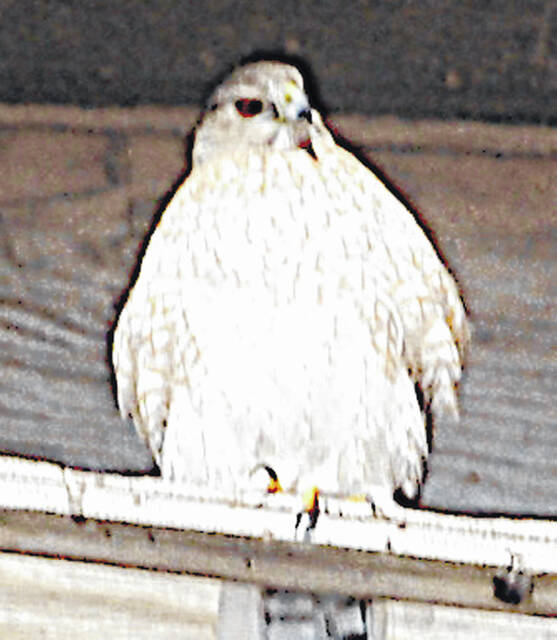

In early January Hillsboro resident Billy McClain first spied an uncommon site atop a building beside the police station in the city’s downtown area — a peregrine falcon.
Kathy Garza-Behr, a wildlife communications specialist with the Ohio Department of Natural Resources (ODNR) Ohio Division of Wildlife, said she has never heard of a peregrine falcon living in Hillsboro and checked the rare bird alerts for Ohio.
McClain, who sells antiques and liquidates real estate in downtown Hillsboro, said he discovered the peregrine falcon on the first cold, snowy and windy day of the year. “At first, I couldn’t tell if it was a hawk or a falcon,” he said. “I knew pigeons were nesting inside the old Parker House, and darned if it didn’t take another loop and come in about 900 miles an hour, and that falcon dove and barely missed a pigeon. It pulled up at the last second, and that’s when I knew what it was.”
Peregrine falcons are probably best known for their amazing flight speed in pursuit of prey. They swoop, diving headfirst toward their prey at speeds that may exceed 200 miles per hour and strike with their talons, usually killing their prey upon impact.
McClain was familiar with peregrine falcons from learning about them in school and on “Wild America”, and he has spotted them on bridges when he worked on bridges as a member of a laborer’s union.
The peregrine falcon was prized by royalty in the Middle Ages, and its nests were sometimes the exclusive property of the nobles. The use of birds of prey in hunting, known as falconry, dates back to 2000 B.C. in ancient Egypt and China and reached Europe by 300 B.C.
Although peregrine falcons are now listed as a common species, they were placed on the federal endangered species list in 1970.
Research showed that the decline was a result of a by-product of DDT, an insecticide that was used in the environment. It accumulated in female peregrines disrupting egg shell formation.
According to the ODNR, the recovery of the peregrine falcon, similar to that of the bald eagle, after the species’ near total extinction from much of the United States is a success story. The peregrine falcon was removed from the federal endangered species list in 1995, and in 2015 it was taken off the list in Ohio.
Along with the ban on DDT, programs administered through ODNR have helped the falcons adapt to nesting on a variety of man-made structures like skyscrapers, bridges and other tall buildings.
While the development of large, urban cities may often be disruptive to wildlife, it has aided in the resurgence of peregrine falcons. The tall buildings mimic the peregrines’ natural habitat of tall cliffs, coastlines and high mountains.
Today, in Ohio, they are typically found in cities in the northeast part of the state.
According to the ODNR, Ohio’s first nesting peregrines successfully fledged two young birds at the Commodore Perry Motor Inn in Toledo. From 1989 until 1993, the Ohio Division of Wildlife helped 46 growing peregrines in Cincinnati, Akron and Columbus.
From there, the population grew steadily and exceeded 30 nesting pairs during 2011. In 2014, the Division of Wildlife confirmed 34 territorial pairs of peregrines statewide.
Although the peregrine falcon as no longer listed as endangered at either the federal or state level, its population continues to be monitored.
Reach John Hackley at 937-402-2571.



